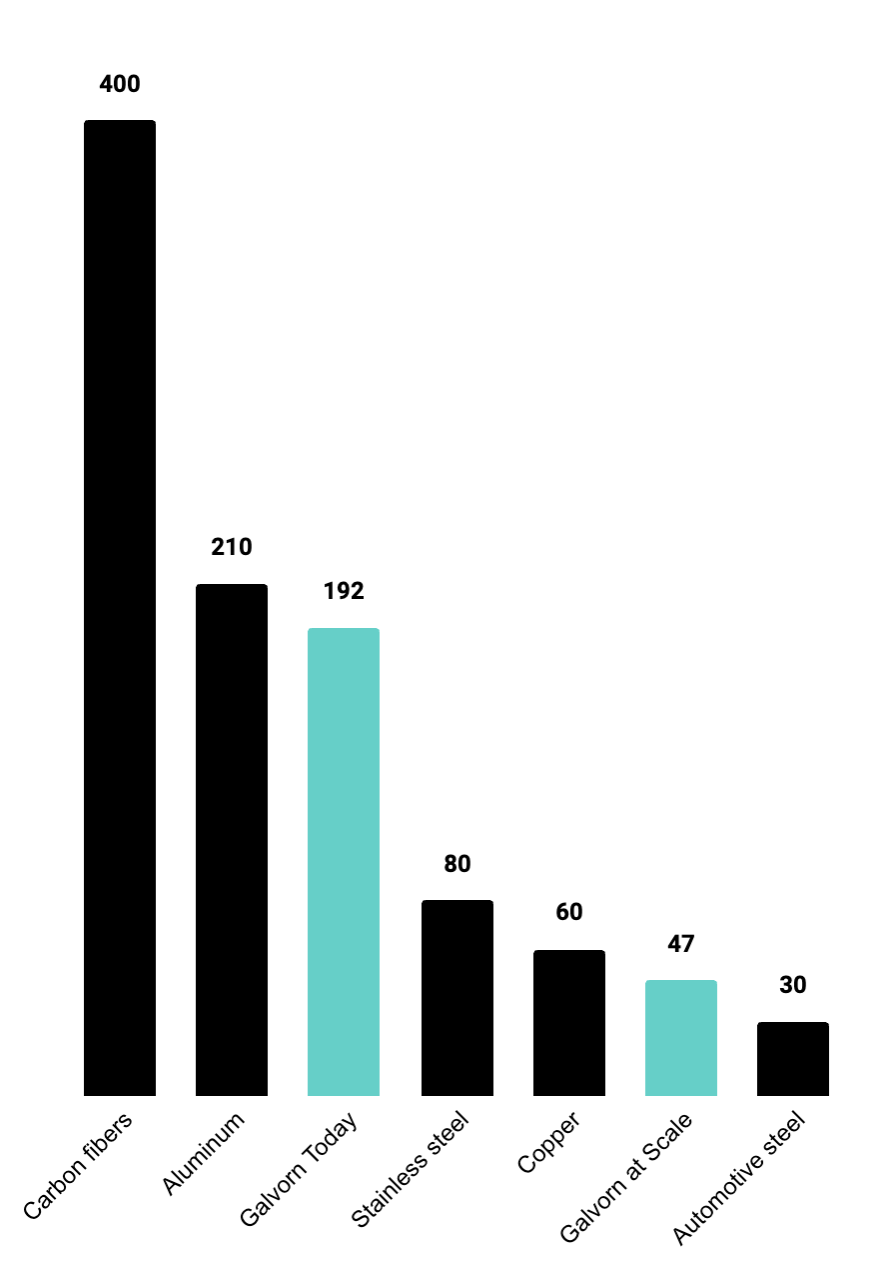Galvorn is the most conductive solid carbon material
Galvorn has the conductivity of metals, while offering significant weight savings and orders of magnitude more strength and flexibility. Galvorn was originally invented by Nobel laureates for high performance space applications, and DexMat has exponentially increased production capacity since its founding to make Galvorn accessible to critical applications on Earth.
01
Conductive
Nearly equivalent to copper on a per mass basis
The electrical conductivity of Galvorn is nearly equivalent to copper on a per mass basis: 6150 Sm2/kg versus copper 6300 (Sm2/kg). Galvorn can conduct the same amount of electricity as copper, but requires more volume to do so (remember: it’s very lightweight!). Many wire applications, such as signal and data transfer wires, do not require the full conductivity of copper.
02
Lighter
80% less dense than copper
Galvorn’s density is 1.6 g/cm3. Copper’s density is 9.0 g/cm3 and aluminum’s density is 2.7 g/cm3. Galvorn wire and cable offers significant lightweighting benefits for aerospace, defense, and automotive applications. The growing need for sensors and data transmission in these industries only increases the Galvorn’s opportunity for lightweighting impact.
03
Stronger
50x stronger than copper
Weight for weight, Galvorn is 50x stronger than copper. (And 15x stronger than steel.) The durability of Galvorn wire and cable holds significant promise for applications in extreme environments, as well as manufacturing, distribution, and/or installation efficiencies.
04
Flexible
100x flex life of copper
Like its strength, Galvorn’s exceptional flex tolerance promises superior durability in the end-use application, as well as potential manufacturing, distribution, and/or installation efficiencies. Notably, Galvorn’s bend radius is extremely small; you can tie Galvorn fibers into a knot without causing damage. Or, more practically speaking, you can install Galvorn wiring solutions in much tighter spaces, making more efficient use of space overall.
More reasons to choose Galvorn
Thermally Conductive
17% more than copper
Galvorn has higher thermal conductivity than copper: 450 W/m-K versus copper at 385 W/m-K. Higher thermal conductivity makes it better at dissipating heat, carrying more current on a per mass basis. Some applications need their conductive wire to handle higher current.
Corrosion-Resistant
No rusting, no pitting, even over years
Galvorn is carbon. The carbon-carbon bonds in carbon nanomaterials are similar to graphite or diamond. These bonds resist oxidation and chemical reactions under standard conditions (e.g., air, water, or mild acids), making it inherently stable.
Flame-Resistant
It does not melt, it’s REALLY hard to burn
Galvorn exhibits flame resistance due to its unique chemical composition, atomic structure, and thermal properties. While it’s not completely immune to burning—it can oxidize under extreme conditions—its resistance to flames is exceptional.
Biocompatible
Strong, microscopic, flexible carbon fibers
Galvorn is used in developing advanced biocompatible applications, including as a neural probe for the brain. Its strength allows it to be formed into flexible fibers as small as 5 µ, thus less invasive to the body. It does not react or corrode in the human body the way metals do.
Cut-Resistant
Backed by science (and lumberjacks)
Scientists (and lumberjacks!) have tested the cut-resistance of Galvorn fibers. In this study Galvorn carbon nanotube fibers handily outperform Kevlar, Dyneema, and fiberglass. This characteristic holds promise for wiring that must hold up to extreme environments.
Capacitive Sensing
For smart garment technology
Capacitive touch sensing technology plays a key role in smart garment technology. Galvorn has a very high surface area, which in addition to its conductivity, makes it excellent at interfacing electrically with the human body in wearables or e-textile applications.
Sustainable to Produce
Galvorn production at scale is higher-performing, less energy-intensive, less expensive, and more geopolitically resilient than today’s most pervasive metals. Additionally, unlike metals, its feedstocks do not require the broad destruction of land and ecosystems, which result from mining ore.
In fact, Galvorn feedstock can be produced from natural gas and biogas, abating greenhouse gases like methane and carbon dioxide from entering our atmosphere (and clean hydrogen is a byproduct!).

Recyclable—and Doesn’t Lose Properties
It is also recyclable. We recycle Galvorn on a regular basis, but Rice University researchers, including our very own Co-Founder and Chief Science Advisor, Matteo Pasquali, PhD, and our Process Development Engineer, Oliver Dewer, PhD, demonstrated that carbon fibers made out of carbon nanotubes (aka Galvorn) can be fully recycled from mixed streams (i.e., in realistic conditions for end-of-life recycling). Their work was recently published in the journal Carbon (Elsevier).
Purchase samples of Galvorn
For production orders, please contact us. Pricing in our store is for small batch orders only.




